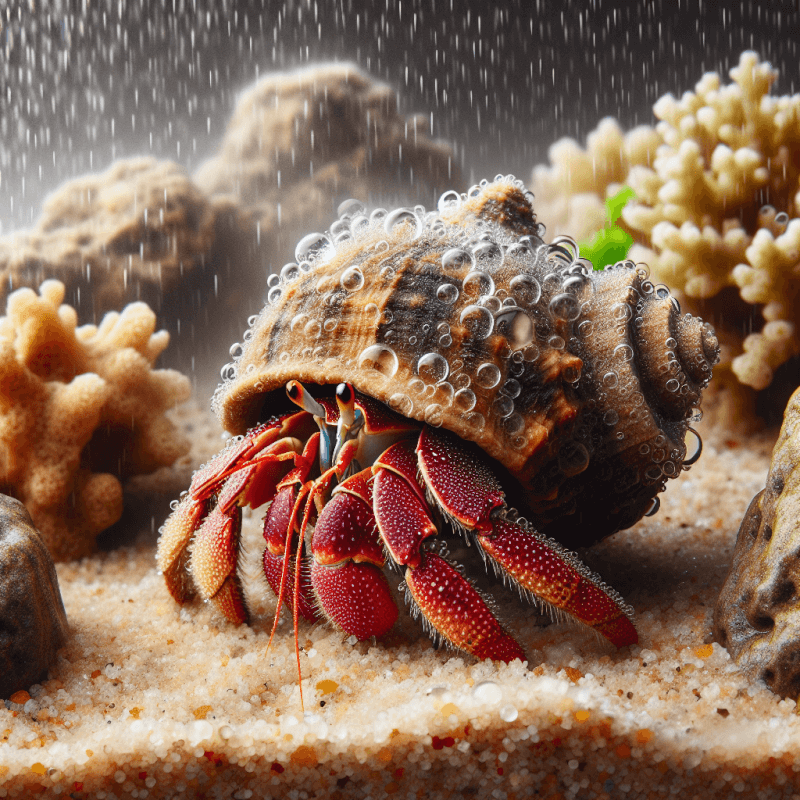If you’ve recently welcomed a hermit crab into your home as a new pet, one thing you may be wondering about is how to maintain the ideal level of humidity for their habitat. After all, hermit crabs are native to tropical environments, and ensuring that they have a comfortable living space is essential to their well-being. But fear not! In this article, we will explore some simple yet effective ways to ensure proper humidity for your little crab friend, so they can thrive in their new home. So let’s get started!
Choosing the Right Substrate
When it comes to creating the perfect habitat for your hermit crab, choosing the right substrate is crucial. Substrate refers to the material that lines the bottom of your crab’s enclosure. It serves multiple purposes, including providing a comfortable surface for your crab to walk on, allowing for burrowing, and most importantly, retaining moisture.
Types of Substrates
There are various types of substrates available for hermit crab enclosures. One popular choice is coconut fiber, also known as coconut coir. This substrate is excellent at retaining moisture and provides a natural and organic environment for your crab. Another option is a mix of sand and peat moss, as it allows for better drainage and creates a suitable habitat for burrowing.
Moisture-retaining Substrates
When choosing a substrate for your hermit crab, it’s essential to select one that can retain moisture. Hermit crabs thrive in a humid environment, so ensuring that the substrate can hold onto moisture is key. Not only does this help maintain the humidity level, but it also keeps the substrate from becoming too dry, which can be harmful to your crab’s health.
Adding a Water Dish
One of the easiest ways to provide your hermit crab with the necessary humidity is by adding a water dish to its enclosure. A water dish serves as a source of hydration for your crab, but it also helps increase the overall humidity in the habitat.
Importance of a Water Dish
A water dish is crucial for your hermit crab’s well-being. Not only does it provide essential drinking water, but your crab will also use it to moisten its gills and maintain the moisture level in its shell. Without a water dish, your hermit crab may become dehydrated, leading to various health issues.
Size and Placement of the Water Dish
When choosing a water dish for your hermit crab, make sure it is shallow enough for your crab to get in and out easily. A small dish, such as a shallow ceramic dish or a jar lid, works well. Additionally, place the water dish in a strategic location within the enclosure to control the humidity effectively. Position it away from direct heat sources to prevent excessive evaporation.

Misting the Habitat
Another method to ensure proper humidity for your hermit crab is through misting the habitat. Misting involves spraying water onto the substrate and the enclosure’s walls, creating a humid environment for your crab.
Why Misting is Important
Misting contributes to maintaining the ideal humidity level needed for your hermit crab’s health. By spraying water onto the substrate, you add moisture to the environment, which your crab absorbs through its gills. Misting also supports the molting process by providing the necessary humidity for successful shedding of the exoskeleton.
Using a Spray Bottle
To mist your hermit crab’s habitat, a simple spray bottle filled with dechlorinated water is all you need. Gently spray the walls and substrate, making sure not to soak the enclosure excessively. Aim for fine droplets that will evaporate slowly, providing prolonged humidity. Regular misting, especially in the morning and evening, will help maintain the desired moisture levels.
Covering the Habitat
Covering your hermit crab’s habitat is another effective way to regulate humidity levels. By covering the enclosure, you create a controlled environment that retains moisture and mimics your crab’s natural habitat.
Types of Covers
There are various options for covering your hermit crab’s enclosure. Some people prefer using a glass or acrylic lid, which provides a clear view of your crab while trapping humidity inside. Others opt for a mesh cover, which allows for better airflow while still maintaining adequate humidity. Whichever cover you choose, ensure that it fits securely and prevents any moisture from escaping.
Creating a Humid Environment
By covering the habitat with a suitable lid, you create a microclimate that traps the moisture within. This helps establish the required humidity level for your hermit crab. Remember to periodically check the enclosure’s humidity and adjust the covering accordingly to avoid excess moisture buildup.

Using a Hygrometer
To maintain proper humidity for your hermit crab, it’s essential to monitor and adjust the humidity levels within the enclosure. A hygrometer is a device specifically designed to measure humidity.
What is a Hygrometer?
A hygrometer is a tool that measures the amount of moisture in the air, allowing you to monitor the humidity accurately. It typically displays the humidity percentage on a digital or analog screen and helps you determine if adjustments to the habitat are necessary.
Monitoring and Adjusting Humidity
With a hygrometer, you can regularly check the humidity inside your hermit crab’s enclosure. Aim for a humidity level between 70% and 80% for optimal health. If the humidity falls below this range, you can mist the habitat or adjust the covering to increase moisture. If the humidity exceeds the desired range, you can increase airflow or make slight alterations to the covering to lower humidity.
Maintaining Proper Ventilation
While maintaining humidity is crucial, ensuring proper ventilation within the enclosure is equally important. Ventilation helps prevent stagnant air, removes excess moisture, and provides fresh air for your hermit crab.
Importance of Ventilation
A well-ventilated habitat helps prevent the growth of harmful bacteria and fungal infections that thrive in stagnant and humid environments. Good airflow also discourages the buildup of ammonia from your crab’s waste, creating a healthier living space.
Avoiding Excessive Moisture
When designing your hermit crab’s habitat, ensure there are enough ventilation holes or slits in the enclosure. This allows fresh air to circulate without causing a significant drop in humidity. Additionally, periodic air exchange by briefly removing the lid or opening the enclosure’s door can help maintain the right balance between humidity and ventilation.

Controlling Room Temperature
Temperature plays a significant role in maintaining humidity levels for your hermit crab. There is a direct relationship between temperature and humidity, so it’s important to keep the enclosure at an appropriate temperature.
Temperature and Humidity Relationship
Warmer temperatures lead to higher evaporation rates, increasing the humidity in the enclosure. However, excessively high temperatures can cause excessive drying and loss of moisture, adversely affecting your hermit crab. By regulating the room temperature, you can control the humidity levels and provide a comfortable environment for your crab.
Using a Heater or Air Conditioner
To maintain a consistent temperature, consider using a heater or air conditioner in the room where the hermit crab’s enclosure is located. These devices ensure that the temperature remains within the optimal range, preventing extreme fluctuations that can disrupt the humidity balance.
Adding Humid Hiding Spots
Creating humid hiding spots within the hermit crab’s habitat is beneficial for their overall well-being. These hiding spots provide your crab with a retreat where they can find comfort and solitude.
Creating Hiding Spots
To create a humid hiding spot, you can use a small container filled with damp substrate, such as coconut fiber or moss. Your hermit crab will seek refuge in these areas to maintain the moisture levels in their shell and regulate their body temperature.
Importance of Humidity for Molting
Humidity is particularly crucial during molting, which is the process of shedding the old exoskeleton and growing a new one. Moisture helps soften the exoskeleton, making it easier for the crab to shed. By providing humid hiding spots, you ensure that your crab has a suitable environment for successful molting.

Using a Humidifier
In some cases, increasing humidity levels can be challenging, especially in dry climates. Using a humidifier can help resolve this issue by adding moisture to the air.
Types of Humidifiers
There are various types of humidifiers available, including ultrasonic, evaporative, and steam humidifiers. Ultrasonic humidifiers produce a cool mist by vibrating water droplets, while evaporative humidifiers use a fan to evaporate water into the air. Steam humidifiers heat water to create steam that is released into the environment. Choose a humidifier that suits your needs and ensure it is safe for your hermit crab’s habitat.
Placement and Usage
When using a humidifier, place it near the hermit crab’s enclosure, but ensure it doesn’t directly blow mist or steam onto the habitat. This prevents excessive moisture buildup in the crab’s habitat while still increasing the overall humidity in the room. Follow the manufacturer’s instructions for optimal usage and monitor the humidity levels using a hygrometer to ensure they remain within the desired range.
Avoiding Direct Sunlight and Drafts
While lighting is essential for your hermit crab’s natural day-night cycle, direct sunlight should be avoided. Additionally, drafts can negatively impact the humidity and temperature levels in the enclosure.
Negative Effects of Direct Sunlight
Direct sunlight can rapidly increase the temperature within the enclosure, causing excessive evaporation and reducing humidity levels. It can also lead to hotspots that can be harmful to your hermit crab’s health. Too much exposure to direct sunlight can lead to dehydration and stress.
Preventing Drafts
Drafts can cause fluctuations in temperature and humidity, which can be detrimental to your hermit crab. Avoid placing the enclosure near windows or air vents where drafts are likely to occur. If necessary, use curtains, blinds, or insulation to prevent drafts from entering the area. This helps maintain a stable and suitable environment for your crab.
With the proper understanding and implementation of these strategies, you can ensure that your hermit crab thrives in a habitat with the ideal humidity levels. Remember to regularly monitor the humidity and temperature, adjust as necessary, and provide ample water sources and hiding spots to keep your crab happy and healthy.



